Creating your own simple garden as a beginner involves several easy steps. Don’t be intimidated by gardening; it’s a fun and rewarding experience that anyone can enjoy. With a little planning and patience, you’ll be harvesting your own fresh fruits and veggies in no time.
Key Takeaways
- Choose a convenient location for your simple garden.
- Start small with raised beds or containers.
- Set up an automatic watering system or use a hose.
- Fill the bed with a mix of compost, peat moss or coconut coir, and vermiculite.
- Find a planting guide for your area.
- Visit your garden daily to observe problems and catch them early.
- Harvest your homegrown produce and enjoy them in your meals.
Choose a Convenient Location with Adequate Sunlight and Water Source
First, choose a convenient location with ample sunlight and a nearby water source. Selecting the right location for your garden is crucial, as it determines how well your plants will grow. Look for a spot that gets at least 6-8 hours of sunlight, preferably in the morning. Using apps like Sun Seeker can help you determine the amount of sunlight each area in your yard receives.
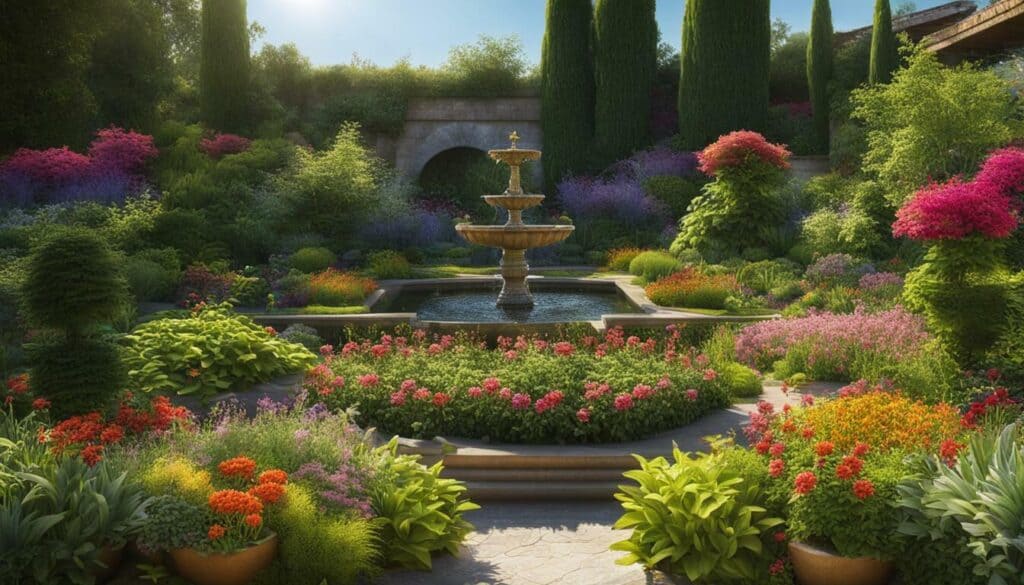
It is also important to have a convenient water source nearby or within hose distance to make watering your garden an easy task. You can even set up an automatic watering system, such as an automatic timer connected to a hose bib, with a soaker hose or drip line going towards the garden. This ensures consistent watering even when you are busy or away.
Raised beds are a great option for starting a garden, as they are easy to construct and allow for better soil control. When constructing a raised bed, it is important to add the right soil mix, which includes compost, peat moss or coconut coir, and vermiculite, to ensure optimal growth of your plants. The amount of soil needed depends on the size of the bed, and adding fresh compost each time you plant is recommended.
Before planting, consult a planting guide specific to your area to determine the best time for planting. Plant what you like to eat, and make sure to spend time daily in your garden, observing and managing any issues that may arise. By following these tips, you can successfully start and maintain a simple garden in a convenient location with adequate sunlight and water source.
Consider Raised Beds or Containers for Easy Gardening
Consider adding a raised bed or using containers for gardening. It is the perfect solution for beginners and those with limited space. Raised beds and containers are low maintenance and allow you to control the soil quality and drainage. Here are some steps to guide you in creating a low maintenance garden:
| Step | Description |
|---|---|
| 1 | Choose the best location for your garden. It should be a spot where you will see and walk by often. Look for a spot that gets 6-8 hours of sun and has a nearby water source. |
| 2 | Add a raised bed to your garden. Start with a small one, like a 4×8 foot bed, and aim for a depth of 12-18 inches. This size is easy to construct and allows for a lot of food to be grown. Alternatively, you can use large pots or half wine barrels for container gardening. |
| 3 | Set up a watering system. An automatic watering system connected to a timer and hose or drip line is best. This will ensure that your plants are consistently and efficiently watered. Consider using watering grids for raised beds. |
| 4 | Add the right soil to your raised bed. Raised beds allow you to use a fresh mix of soil, instead of relying on existing soil. Mix compost, peat moss or coconut coir, and vermiculite to create a fertile soil mix. Amend the soil with organic fertilizer and consider getting it tested annually. |
| 5 | Find a planting guide for your area and follow it. Timing is crucial in gardening, so refer to a planting guide to know when and what to plant. Local extension offices and nurseries are good sources for planting guides. |
| 6 | Plant what you like to eat. Research the vegetables you want to grow and understand their growing requirements. Some vegetables are best planted from seeds, while others are better started as seedlings. Water new seeds and seedlings regularly to ensure their survival. |
| 7 | Spend time in your garden each day. Take a walk around your garden, observe the progress of your plants, and address any problems like pests or diseases. Catching issues early will make them easier to manage. |
| 8 | Harvest and enjoy what you grow. Pick your produce when they are young for continued production. Use your garden harvest in your meals and try new recipes. Soups and smoothies are great ways to incorporate fresh vegetables. |
By considering raised beds or containers for your beginner’s garden, you can make gardening easier and more enjoyable. Start with a small garden and gradually expand as your ability and experience grow. Happy gardening!
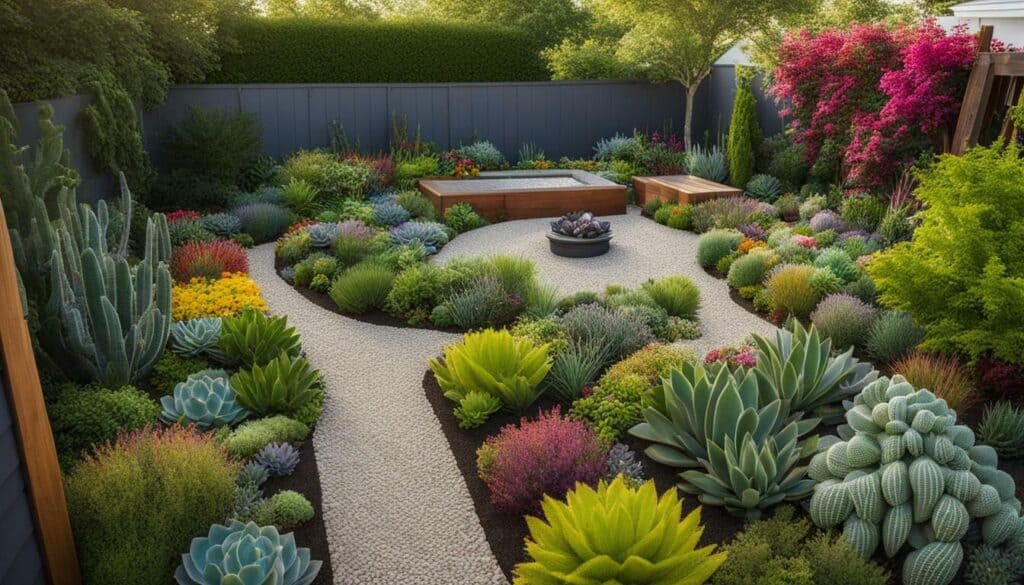
Set Up an Automatic Watering System and Prepare the Soil
To create a successful garden, it’s important to set up an automatic watering system and prepare the soil appropriately. For beginners, this might seem like a daunting task, but it’s easy to do with the right tools and guidance.
First, choose a convenient location for the garden that receives at least 6-8 hours of sunlight and has a water source nearby. Consider adding a raised bed, which should be a good starting point and at a depth of 12-18 inches.
Once you have chosen your location and raised bed, it’s time to set up a watering system. An automatic watering system ensures that your plants receive the right amount of water without you having to remember to water them every day. A battery-operated timer connected to a soaker hose or drip line is an excellent choice for beginners, as it’s easy to use and maintain.
After setting up your watering system, it’s time to add soil to the raised bed. Use a mix of compost, peat moss or coconut coir, and vermiculite to create a well-aerated and nutrient-rich soil. It’s important to test your soil each year to ensure its health, which can be done through your local agricultural extension office.
Follow a planting guide specific to your area and choose plants you enjoy eating. Spend time in the garden each day to observe and manage any issues.
By following these simple steps for setting up an automatic watering system and preparing the soil, you’ll be well on your way to creating a successful garden in an urban environment. Don’t forget to harvest and enjoy the fruits of your labor!

Choose the Right Plants for Your Simple Garden
Use a planting guide specific to your area and plant vegetables or herbs that you enjoy eating. Determine whether they are best grown from seed or seedlings. Consider the location of your garden and the amount of space you have available. Are there certain plants that require more space or sunlight than others? Choose plants that are well-suited for container gardening if you have limited space or want to keep your garden on a patio or balcony.
When selecting your plants, it’s important to keep in mind the level of maintenance required. Some plants are more low-maintenance than others, which can be beneficial for beginner gardeners. For example, leafy greens like lettuce and spinach are relatively easy to grow, while tomatoes and peppers require more attention and care.
Organic gardening tips can be especially useful when selecting your plants. Consider using natural pest control methods and companion planting to promote healthy growth and deter pests. Companion planting involves placing certain plants together that support each other’s growth. For example, planting basil next to tomatoes can help prevent tomato pests and improve flavor.
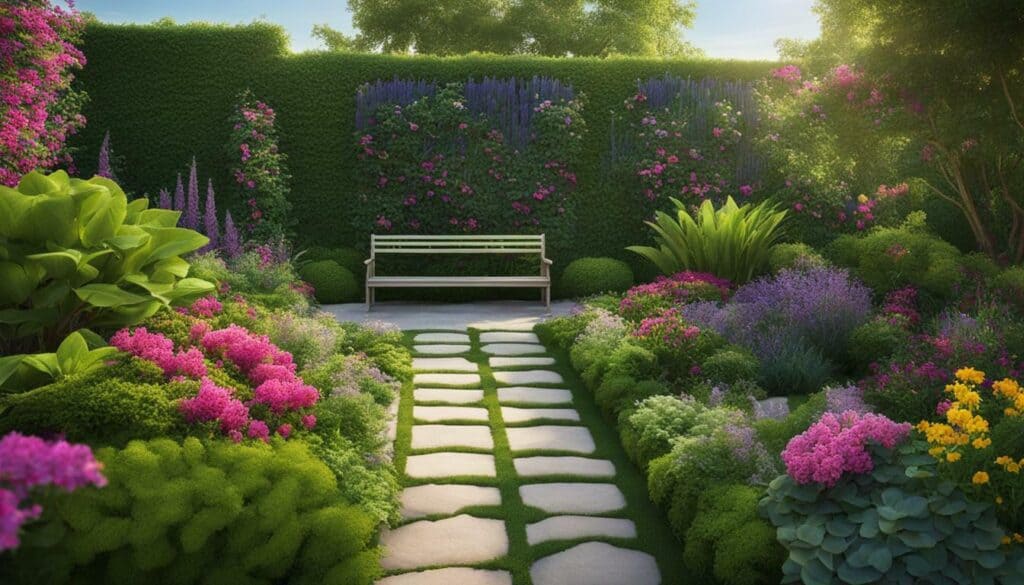
Don’t be afraid to try something new in your garden! Experiment with different plant varieties and see what works best for you. You might find that you have a green thumb for certain plants and struggle with others. Keep track of what you plant each season and how well they grow so that you can adjust your garden plan in the future.
Observe and Tend to Your Simple Garden Regularly
Spend time in your garden each day to observe and address any issues that may arise. This is the best way to ensure the health and well-being of your plants. Regular care and attention can prevent problems from becoming too big to handle, and can help you catch any issues early on, when they are easiest to address.
One of the first things to consider when tending to your simple garden is the location. Make sure your garden has access to at least 6-8 hours of sunlight each day, as this is crucial for plant growth. If your garden is in a location where it doesn’t receive enough sunlight, consider moving it to a better spot or using shade cloth to protect your plants from harsh sun rays.
Another important aspect of garden care is watering. An automatic watering system, such as a soaker hose or drip line with an automatic timer, can ensure that your plants receive consistent and adequate amounts of water. This can help minimize stress to the plants and prevent over or under watering.
Regularly testing and amending your soil is also important for maintaining a healthy garden. Adding organic fertilizer to your soil can help provide essential nutrients that your plants need to grow and thrive. Follow a planting guide that is specific to your area to ensure that you’re planting the right vegetables for your climate and region.
Finally, spending time in your garden can be enjoyable and rewarding. Harvesting your crops at the right time and enjoying the fruits of your labor is a great way to connect with nature and improve your overall wellbeing. There’s nothing quite like the taste of fresh, homegrown produce!
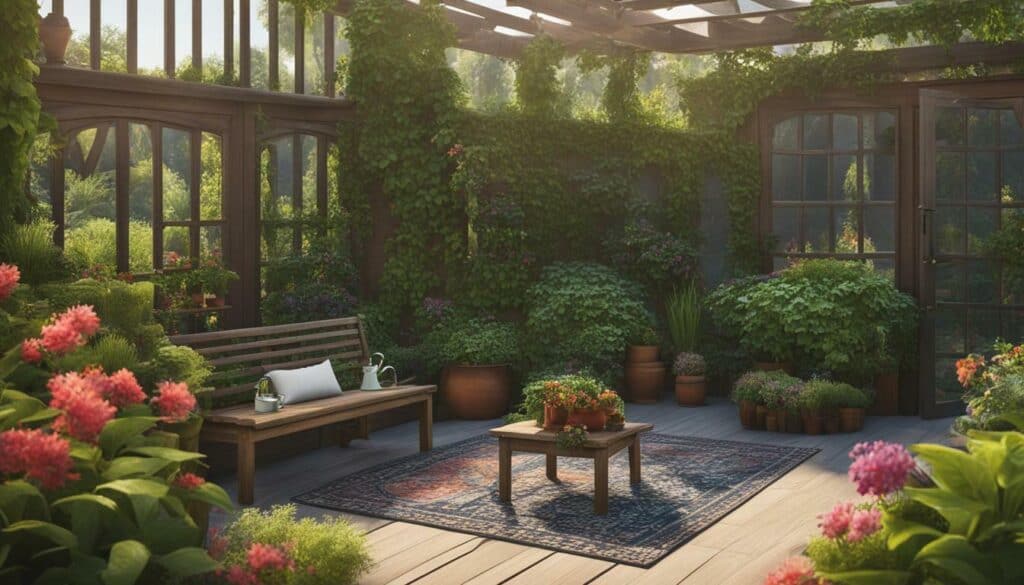
“A garden requires patient labor and attention. Plants do not grow merely to satisfy ambitions or to fulfill good intentions. They thrive because someone expended effort on them.” – Liberty Hyde Bailey
Harvest and Enjoy the Fruits of Your Simple Garden
Finally, harvest and enjoy the food you grow! There is nothing more satisfying than enjoying fresh produce that you have grown yourself. Whether it’s a juicy tomato, a crisp cucumber, or a bundle of delicious herbs, the fruits of your labor are a delicious addition to any meal.
When it comes to harvesting, it’s important to know when to pick your produce. Each vegetable or fruit has its own specific time for harvesting, so it’s important to do your research and follow a planting guide. Be sure to handle your produce with care, as bruising or damage can lead to spoilage.
Incorporating your fresh produce into meals is a fun and creative way to enjoy the fruits of your labor. Try new recipes with herbs, experiment with different cooking methods for your vegetables, and share your bounty with friends and family.
Organic gardening tips can help maintain the health and flavor of your produce. Avoid using chemical pesticides and fertilizers, instead opting for natural methods such as companion planting and crop rotation. These methods promote soil health and reduce the risk of disease and pests in your garden.
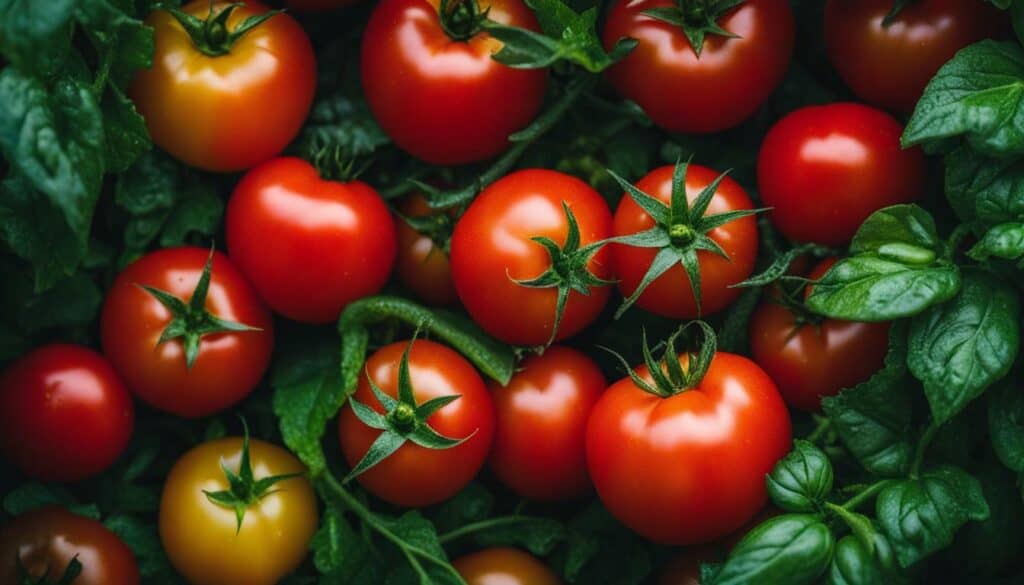
Remember, gardening is a continuous learning process. As you harvest and enjoy your produce, take notes on what worked well and what didn’t. Use this information to improve your garden for next season.
With a little effort and patience, anyone can successfully grow their own simple garden. So don’t be afraid to get started today! Your taste buds will thank you.
Acquire Basic Garden Tools and Test Your Soil
Acquiring basic garden tools like a shovel, rake, and hose, and testing your soil to determine its pH and nutrient makeup is essential to starting a successful simple garden. Without the proper tools, it can be difficult to maintain a healthy garden. Below are some essential gardening tools that every beginner needs:
| Tool | Purpose |
|---|---|
| Shovel | Used for digging and moving soil and other materials. |
| Rake | Used for leveling soil and removing debris from the garden. |
| Hose or Watering Can | Used for watering the plants in your garden. |
Testing your soil is equally important, as it can provide information on the pH level and nutrient content of the soil. Knowing this information allows you to make necessary amendments for optimal plant growth. Here are some steps to test your soil:
- Take soil samples from different areas of your garden using a soil test kit.
- Follow the instructions on the kit to analyze the soil samples and determine pH and nutrient levels.
- Add the necessary amendments, such as compost or lime, to adjust the pH and nutrient levels as needed for optimal plant growth.
By having the right tools and knowledge about your soil, you can set your simple garden up for success and enjoy a bountiful harvest.
Note: If you plan to have a larger garden or need more advanced tools, consider renting or borrowing equipment from a tool library or garden center instead of purchasing everything.
Prepare the Soil and Plant Your Chosen Seeds or Transplants
Finally, prepare the soil and plant your chosen seeds or transplants. Before planting, it is essential to test the soil to understand its nutrient content and pH levels. This can be done using a simple soil test kit available at most gardening stores. Once you have an idea of the soil’s composition, it’s time to prepare it for planting.
If you’re using raised beds, fill them with a mixture of compost, peat moss or coconut coir, and vermiculite. This mix provides the necessary nutrients and proper drainage for plant growth. If you’re using containers, make sure they have proper drainage holes at the bottom and fill them with potting soil.
It’s important to follow a planting guide specific to your area and climate. This will help you choose the right plants that will thrive in your garden. When selecting plants, consider what you and your family like to eat. It’s best to start with easy-to-grow plants such as tomatoes, lettuce, and herbs.
Once you have your plants, it’s time to plant them in the soil. Make sure to follow the instructions on the seed packets or transplants carefully. Ensure that each plant has enough space to grow and that they are planted at the appropriate depth.
After planting, water the plants well and cover the soil with a layer of mulch. Mulching helps to retain moisture in the soil and suppresses weed growth. It’s important to spend time in the garden each day to observe and address any issues that may arise.
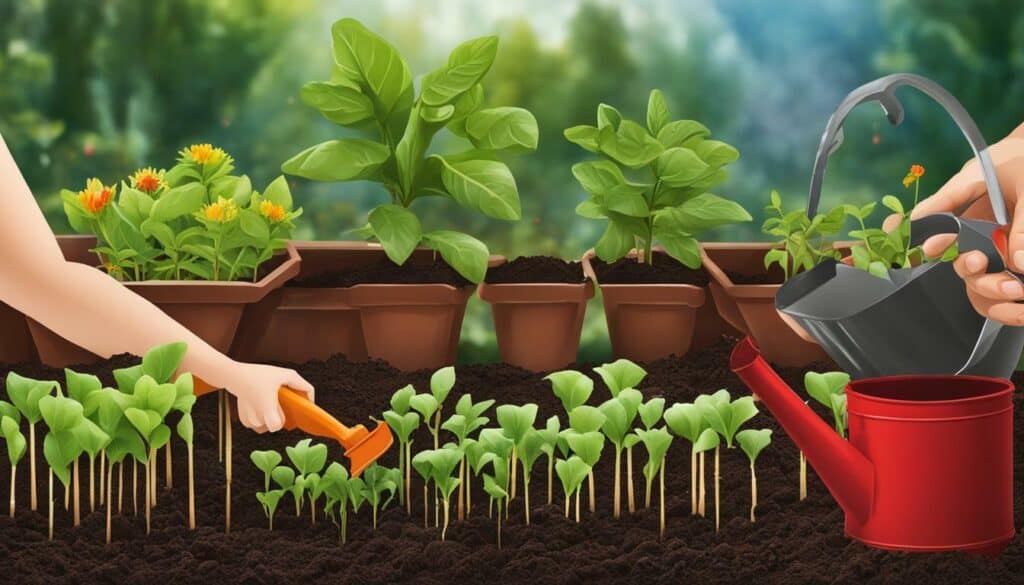
Remember, preparing the soil and planting your chosen seeds or transplants is just the beginning of your gardening journey. With patience, dedication, and a little bit of luck, your garden will flourish, and you will be able to enjoy the fruits of your labor.
Create Your Own Simple Garden: Easy Steps for Beginners
In Conclusion
In conclusion, creating your own simple garden as a beginner is an enjoyable experience that requires just a few easy steps. By choosing a convenient location with adequate sunlight and water, considering raised beds or containers for easy gardening, setting up an automatic watering system and preparing the soil, choosing the right plants for your simple garden, and observing and tending to your garden daily, you can reap the rewards of a successful garden.
Acquiring basic garden tools and testing your soil are also important steps to ensure optimal growth. By following a planting guide and preparing the soil, you can plant your chosen seeds or transplants with confidence.
Starting a simple garden is a great way to connect with nature and the environment, and with a little dedication and care, you can enjoy the fruits of your labor. So, take the plunge and start your gardening journey today. Happy gardening!
FAQ
Q: What are the steps involved in creating a simple garden for beginners?
A: The steps involved in creating a simple garden for beginners include choosing a convenient location with adequate sunlight and a water source, considering raised beds or containers for easy gardening, setting up an automatic watering system and preparing the soil, choosing the right plants for your garden, observing and tending to your garden regularly, harvesting and enjoying the fruits of your labor, acquiring basic garden tools and testing your soil, and finally, preparing the soil and planting your chosen seeds or transplants.
Q: How do I choose the right location for my garden?
A: To choose the right location for your garden, look for an area with ample sunlight and a nearby water source. Consider the accessibility of the location and ensure it is convenient for you to spend time in your garden.
Q: What are the benefits of using raised beds or containers for gardening?
A: Raised beds or containers provide several benefits for gardening beginners. They offer better control over soil quality, reduce the risk of weeds, and make gardening easier by minimizing bending and kneeling. They are also a great option for those with limited space or poor soil conditions.
Q: Why should I set up an automatic watering system and prepare the soil?
A: Setting up an automatic watering system ensures that your plants receive an adequate amount of water consistently. This can be especially helpful for busy individuals or those who tend to forget to water their plants regularly. Preparing the soil is essential for creating an ideal growing environment for your plants, providing them with necessary nutrients and a suitable texture for root development.
Q: How do I choose the right plants for my simple garden?
A: When choosing plants for your simple garden, consider your personal preferences and the specific growing zone you are in. Select plants that thrive in your region and that you enjoy eating. It’s also helpful to consult a planting guide specific to your area.
Q: Why is it important to observe and tend to my simple garden regularly?
A: Regularly spending time in your garden allows you to observe any issues that may arise, such as pests or diseases, and take necessary actions to address them. It also gives you the opportunity to provide care and maintenance to your plants, ensuring their healthy growth.
Q: How do I harvest and enjoy the produce from my simple garden?
A: Harvesting and enjoying the fruits of your labor is one of the most rewarding aspects of gardening. Simply pick ripe fruits and vegetables from your plants when they are ready to be harvested and incorporate them into your meals or share them with others.
Q: What basic garden tools do I need and why should I test my soil?
A: Basic garden tools such as a shovel, rake, and hose are essential for maintaining your garden. Testing your soil is important to determine its pH level and nutrient makeup, which can help you make informed decisions about fertilizing and amending the soil for optimal plant growth.
Q: How do I prepare the soil and plant my chosen seeds or transplants?
A: To prepare the soil, remove any weeds, rocks, or debris and loosen it with a garden fork or tiller. Add organic matter, such as compost, to improve soil fertility. Follow the instructions on the seed packets or plant tags to determine the appropriate planting depth and spacing for your seeds or transplants.
What Are Some Tips for Beginner Gardeners to Start Their Own Garden?
Here are some essential tips for growing a starter garden: 1. Choose a sunny location with good soil drainage. 2. Start with easy-to-grow plants like herbs, greens, or flowers. 3. Invest in quality gardening tools and supplies. 4. Establish a watering routine and don’t overwater. 5. Properly space your plants to allow for growth. 6. Prune and fertilize as needed to ensure healthy plants. 7. Regularly weed and remove pests to maintain a thriving garden. By following these tips for growing a starter garden, beginners can nurture their green space successfully.
Source Links
- https://growinginthegarden.com/gardening-for-beginners-how-to-start-a-garden-in-8-simple-steps/
- https://www.wikihow.com/Start-a-Garden
- https://commonsensehome.com/start-a-garden/
- https://www.thespruce.com/how-to-start-a-garden-from-scratch-2132778
- https://sebsnjaesnews.rutgers.edu/2020/04/choosing-the-right-location-for-your-vegetable-garden/
- https://www.canr.msu.edu/news/choosing_a_smart_site_for_your_vegetable_garden
- https://www.gardenary.com/blog/where-to-put-your-raised-beds-how-to-choose-the-ideal-location
- https://www.almanac.com/gardening-methods-overview
- https://northernhomestead.com/raised-garden-beds-vs-container-gardens/
- https://homesteadandchill.com/raised-garden-beds-pros-cons/
- https://www.gardenary.com/blog/how-to-set-up-a-super-simple-irrigation-system-for-raised-garden-beds
- https://anoregoncottage.com/diy-garden-watering-system/
- https://www.gardeners.com/how-to/about-snip-n-drip/7886.html
- https://www.housebeautiful.com/lifestyle/gardening/g31965995/plants-every-garden-needs/
- https://www.realhomes.com/advice/how-to-choose-plants-for-your-garden
- https://www.gardenersoasis.com/pick-the-right-plants/
- https://www.omaritani.com/blog/cultivate-your-own-garden
- https://www.bhg.com/gardening/yard/garden-care/ten-steps-to-beginning-a-garden/
- https://www.betterhealth.vic.gov.au/health/healthyliving/gardening-safety
- https://www.gardencityharvest.org/the-real-dirt-garden-city-harvest-blog/2015/08/05/enjoy-the-fruits-of-your-labor-harvesting-basics
- https://www.sandiegouniontribune.com/lifestyle/home-and-garden/story/2020-07-11/garden-mastery-enjoy-the-fruits-and-the-vegetables-of-your-labor
- https://platthillnursery.com/ten-garden-vegetables-fruits-for-beginners/
- https://www.almanac.com/content/3-simple-diy-soil-tests
- https://simplegardenlife.com/simple-garden-tools-2/
- https://www.almanac.com/gardening-tools-guide
- https://www.almanac.com/soil-preparation-how-do-you-prepare-garden-soil-planting
- https://anoregoncottage.com/how-to-plant-seedlings/
- https://www.almanac.com/vegetable-gardening-for-beginners
- https://www.mysimplysimple.com/my-simply-simple/2020/9/8/garden-summary-2020
- https://www.betterhealth.vic.gov.au/health/healthyliving/gardening-for-children
- https://www.betterhealth.vic.gov.au/health/healthyliving/gardens-for-all-a-health-activity

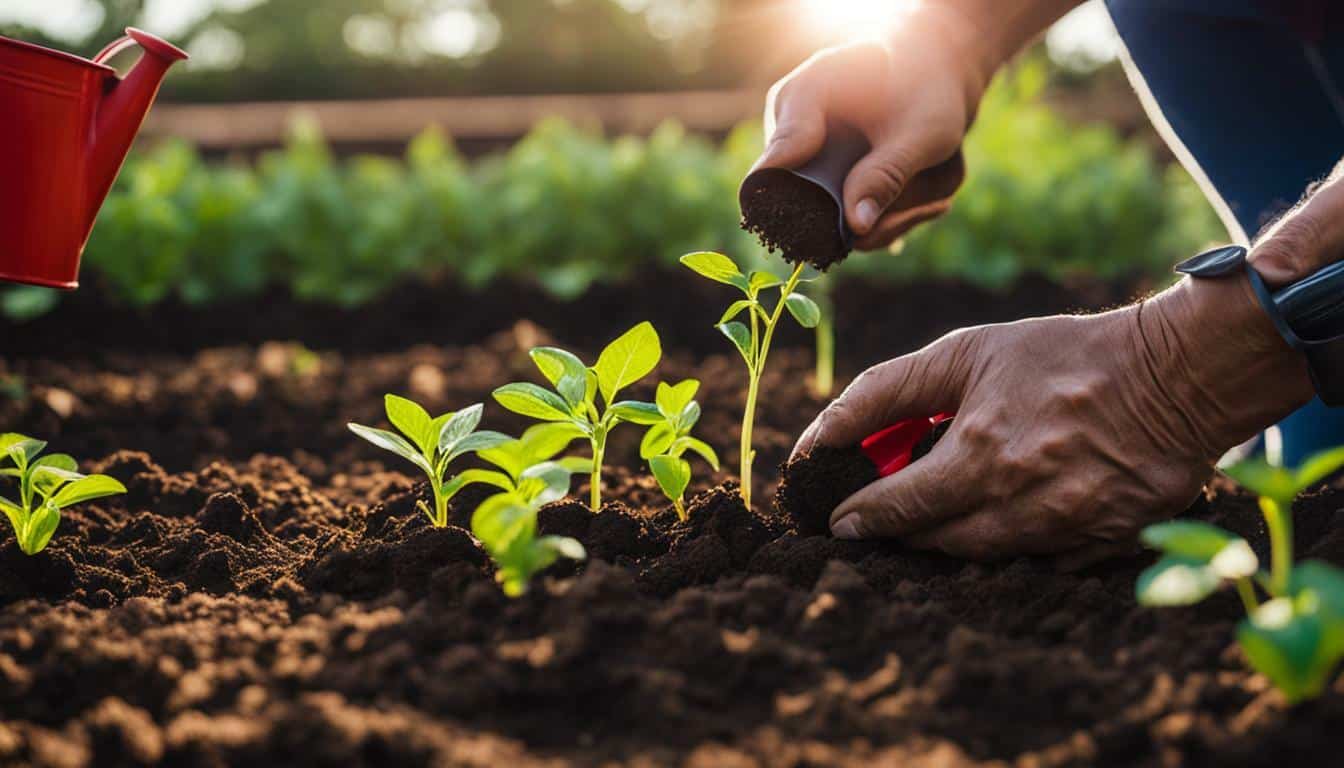




Leave a Reply